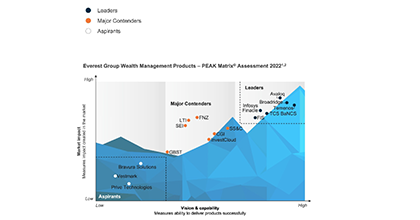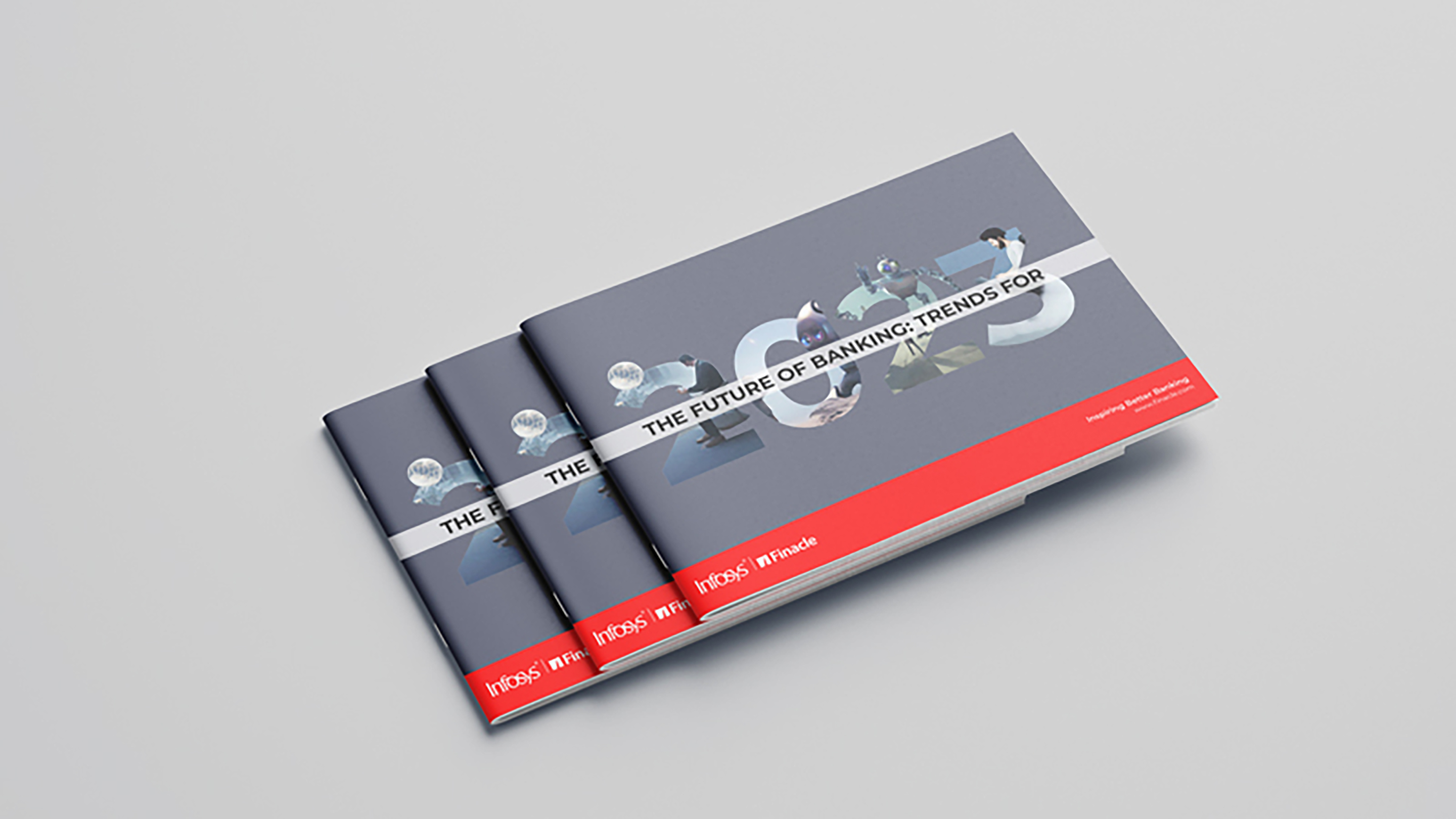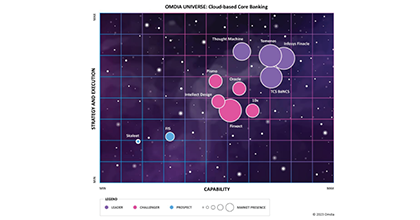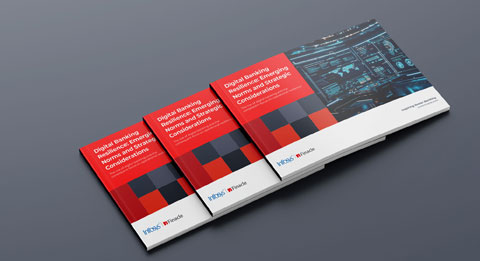-
![]() ESG in bankingESG-conscious banking should create new and future-proof value streams to build a sustainable and resilient business.Read More
ESG in bankingESG-conscious banking should create new and future-proof value streams to build a sustainable and resilient business.Read More -
![Everest Group PEAK Matri Everest Group PEAK Matri]() Everest Group PEAK MatrixA comprehensive solution delivering a full spectrum of wealth products as great experiences. It also improves the productivity of financial advisors and streamlRead More
Everest Group PEAK MatrixA comprehensive solution delivering a full spectrum of wealth products as great experiences. It also improves the productivity of financial advisors and streamlRead More -
![]() Subsidiary of an American Bank in IndonesiaFind out how a leading American bank adapts to a digitalized trade and supply chain finance operations as a part of its larger transformation by leveraging Finacle Trade Finance Solution Suite.Read More
Subsidiary of an American Bank in IndonesiaFind out how a leading American bank adapts to a digitalized trade and supply chain finance operations as a part of its larger transformation by leveraging Finacle Trade Finance Solution Suite.Read More
-
![]() Recomposing Banking: Leading the Digital ContinuumReport gives you a glimpse of the major areas where recomposing banking will create significant impact and value, Infosys Finacle has put together a report on..Read More
Recomposing Banking: Leading the Digital ContinuumReport gives you a glimpse of the major areas where recomposing banking will create significant impact and value, Infosys Finacle has put together a report on..Read More -
![]() Core Banking on Cloud: Navigating to the Fast LaneTake a deep dive into cloud-based core banking and explore the imperatives, opportunities and challenges, and the hallmarks of a robust solution.Read More
Core Banking on Cloud: Navigating to the Fast LaneTake a deep dive into cloud-based core banking and explore the imperatives, opportunities and challenges, and the hallmarks of a robust solution.Read More -
![]() Embracing Payments ComposabilityA step-by-step guide for maximizing Real Time Payment opportunities by embracing Payments Composability...Read More
Embracing Payments ComposabilityA step-by-step guide for maximizing Real Time Payment opportunities by embracing Payments Composability...Read More
-
![]() Shaping Banking’s Next: Banking Technology Trends for 2025 and BeyondThe banking industry has been balancing disruption and opportunity for several years now, and the pace of change shows no signs of slowing as we move into 2025 and beyond.Read More
Shaping Banking’s Next: Banking Technology Trends for 2025 and BeyondThe banking industry has been balancing disruption and opportunity for several years now, and the pace of change shows no signs of slowing as we move into 2025 and beyond.Read More -
![]() Virtual Accounts 2.0: Surpass Conventional Cash Management and Unlock Next-Gen PossibilitiesVirtual Account Management was a groundbreaking shift in the banking landscape, revolutionising use cases like cash concentration, pooling, centralised treasury management, and in-house banking (POBO, ROBO, COBO)Read More
Virtual Accounts 2.0: Surpass Conventional Cash Management and Unlock Next-Gen PossibilitiesVirtual Account Management was a groundbreaking shift in the banking landscape, revolutionising use cases like cash concentration, pooling, centralised treasury management, and in-house banking (POBO, ROBO, COBO)Read More -
![]() Unlocking Hybrid CloudAs banks push forward with their digital transformation agenda, cloud serves as a pivotal enabler. Each bank, at varying stages of adoption, crafts its unique path, dictated by context, regulations, and risk appetite.Read More
Unlocking Hybrid CloudAs banks push forward with their digital transformation agenda, cloud serves as a pivotal enabler. Each bank, at varying stages of adoption, crafts its unique path, dictated by context, regulations, and risk appetite.Read More
-
![]() Banking on CloudThis report from Infosys Finacle delves into the need for accelerating cloud adoption, highlights the current state of the industry, and puts forth key recommenRead More
Banking on CloudThis report from Infosys Finacle delves into the need for accelerating cloud adoption, highlights the current state of the industry, and puts forth key recommenRead More -
![]() Omdia Universe | Cloud-based Core BankingIn the report, Omdia highlights the following key capabilities of leading cloud-based core banking providers:Read more
Omdia Universe | Cloud-based Core BankingIn the report, Omdia highlights the following key capabilities of leading cloud-based core banking providers:Read more
-
![]() Emirates NBDEmirates NBD consolidates its operations on a single version for scalability, agility, and standardization.Read More
Emirates NBDEmirates NBD consolidates its operations on a single version for scalability, agility, and standardization.Read More -
![]() A Global Top 5 BankDiscover how a global top 5 bank headquartered in the US accelerated payments transformation.Read More
A Global Top 5 BankDiscover how a global top 5 bank headquartered in the US accelerated payments transformation.Read More -
![]() Union Bank of IndiaUnion Bank of India launches Union Virtual Connect (UVConn) by leveraging WhatsApp to provide customers personalized banking services.Read More
Union Bank of IndiaUnion Bank of India launches Union Virtual Connect (UVConn) by leveraging WhatsApp to provide customers personalized banking services.Read More

Virtual Personalization Evolution Spectrum for and Immersive Banking Experience With Metaverse
Blogs
Banks have come up a long way in delivering the best of the best Digital Banking experience to their customers. Today, just open your bank application or website, and you’ll find a plethora of services just a tap away. And customers are loving it! As per the world bank report, two-thirds of the world’s population make or receive digital transactions. By 2027, the total digital transaction value is expected to reach the total amount of US$15.17tn. If digital transactions were a country, it would have been the world’s 3rd largest economy! From the ease of access to convenience, lowering the transactional cost to improving geographical reach, digital Banking scores distinction in all checkpoints discounting one: Personalization. Although the banks are trying to make their customers digital experience flawless but none of them makes it to the top 100 mobile apps list as per Forbes survey.
Banking is also about services tailored to your individual needs. The customer is no longer satisfied with being identified by account numbers. Instead, personalized customer journeys should be an approach towards Better Banking. So, an ideal relationship would be a blend of digital banking for day-to-day transactions and a personal relationship with your banker to assist with colossal needs. Can Metaverse be a key to paving the way to this solution?
Key Challenges of Digital Banking
Despite its benefits, there are some Challenges that the banks need to address in their Digital Banking channels:
Personal touch still matters: As per a survey by Deloitte, 73% of people worldwide use Digital Channels of banking such as Online Banking or Mobile Banking at least once a month. Digital banking is a good channel for transactional banking. However, when it comes to solving complex problems, it does miss the required personal touch. There is no better solution than an expert listening to your financial dilemmas and providing a range of tailor-made solutions to address the issue.
Surging Churn Rates: A recent research around the retail banking customers concludes that annual churn rates for the new client near 25% during the first year of relationship. Half of these don’t even make it to the 90-day mark. With most of the conversation being digital, banks don’t even get a chance to retain their customer. Also, customers prefer switching to a new banking application rather than physically going to the branch to get their grievances answered.
Keep offerings relevant: As consumers transposition themselves towards digital and businesses have started increasing their e-commerce capabilities, the appetite for completely virtual yet personalized banking solutions will continue to augment. With this growing shift in digital banking habits, banks need to keep their product offerings relevant to customer needs.
Gen – Z Ready Bank: In the last few years, more than 400 neo-banks have transpired around the Globe. With only a digital focus, they are more agile and ready to offer a seamless experience at a little to no price. Neo-banks pose significant competition in the Digital Banking space. Traditional Banks need to identify opportunities in the digital space to deliver innovative products for the changing consumer needs.
Is Metaverse the Cue?
Although not newly recently introduced, ‘Metaverse’ has been receiving a lot of attraction now. As per Google data for 2021, it is one of the most-searched words on the search engine in many regions. Today, many institutions, whether financial or non-financial are testing the waters in the Metaverse environment to see what’s in it for them as well as their customers.
The concept of Metaverse is introduced to the world as a virtual reality environment where its users interact with a computer-generated environment and other users. AR (augmented reality) and Virtual Reality headsets aid this virtual ecosystem. According to Bloomberg, the metaverse platforms would soon become commercially feasible, with the business totalling $800 billion by 2024. As per Gartner’s predictions, by year 2026, 25% of people would be spending at least one hour in a day on the Metaverse. According to Goldman Sachs and Morgan Stanley, the Metaverse economy might be worth up to $8 to $13 trillion by 2030. Banks are among the entities that are most positioned to meet the Metaverse’s growing need for digitally native currency and identification.
To understand more about how banks can provide more personalised customer experience and enhance the customer journey, click here and read the detailed thought paper on virtual personalisation.



©2025 -Edgeverve Systems Limited | All rights reserved

















